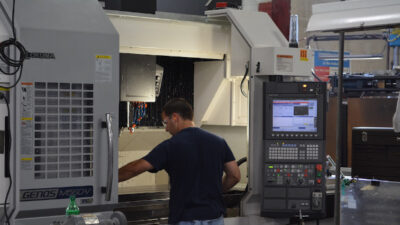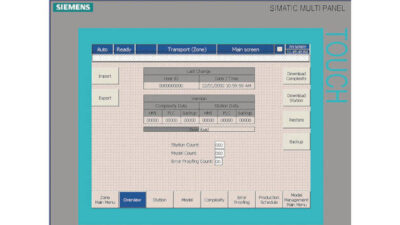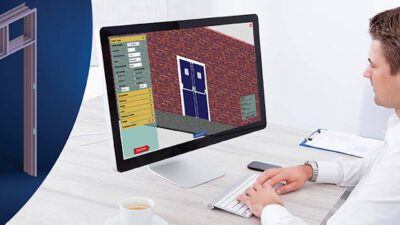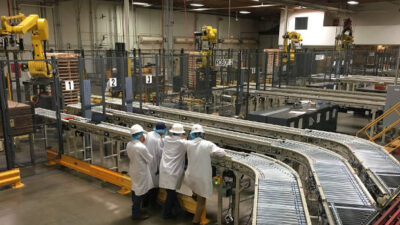A tightly controlled integration plan and the right technology partner helped steelmaker Southland Tube beat the competition.
|
Southland Tube’s operators are able to tweak controls on a massive welder witha remote HMI touchscreen. Source: Siemens
|
At a time when few manufacturers were adding new production lines, Southland Tube broke ground on a strategic new mill near downtown Birmingham, AL: its first plant capable of turning thick sheets of steel into 6- to 12-in. wide circular and square tubing used in heavy duty structures and products, including oil rigs, bulldozers and rail cars. The new facility, Southland’s Mill 5, would enable the firm to expand further into the highly competitive and lucrative large structural steel tubing market before anyone else in the region,
Southland Tube’s plant engineer, Steve Barrett, did much of the work himself — from the electrical engineering for the main power distribution to the very detailed and painstaking design of the automation and control system that would allow operators to electronically manage, monitor, and maintain the massive production and packaging lines seamlessly. Southland Tube’s own design team hand picked the construction contractors, mill manufacturer, production line equipment and machinery.
Mill 5 is by far Southland’s largest tube production facility and the most complex integration job Barrett had ever taken on in more than 20 years as an engineer. It’s the kind of job most plant managers would hand over to a trusted team of systems integrators. However, this plant engineer—a former systems integrator himself—trusted his instincts and opted to keep the bulk of the project in-house. Barrett ultimately spent more than 3,000 hours in one year designing and managing the project.
Barrett says there was never any doubt when it came time to choose the automation platform. "This is a Siemens plant all the way. I was thoroughly convinced upfront that we needed Siemens automation and expertise on our side to have any chance at getting Mill 5 into production before the competitor’s plant," he says.
|
Cabling was a big issue, but Barrett knew it would expedite set-up and eliminate future wiring problems if they could link as many devices as possible on Profibus.
|
As an outside systems integrator, Barrett had relied on Siemens equipment to successfully upgrade and run Southland’s Mill 3, and discovered the Simatic S7-400 programmable logic controller (PLC) when he developed Mill 4 with Siemens equipment after joining Southland fulltime. Barrett says Siemens technology, "and the ease of integration it offers, was at the heart of our [Mill 5] plan from the start. While some companies think Siemens offers a complicated solution, I’m here to tell you we set up this entire steel mill without the aid of Siemens engineering or a large systems integrator."
Nerves of steel
"Steve showed a lot of courage, commitment, and definitely some nerves of steel," says John Barron, an application engineer with Siemens distributor Edison Automation, who helped Barrett program key components of the communications network designed to drive the automated mill. "Despite the pressures of starting up a new mill with a competitor doing everything it can to beat you, Steve never wavered from his integration plan."
|
According to plant engineer Steve Barrett, "The incredible business growth we’ve seen in the past year at Southland Tube has already paid for the new mill’s advanced operating system and yearlong preparation three-times over."
|
Southland Tube pinned its hopes for a speedy plant start up on Barrett’s preparation, upfront engineering, and Siemens control system architecture called Totally Integrated Automation (TIA). For example, Siemens TIA enabled Barrett to dramatically reduce the time it took to program communication between the S7-400 PLCs in the mill control rooms and more than 30 Siemens 6RA70 DC drives in the facility. "Drives communication can be very tricky and time consuming to set up," says Barrett. "Using Siemens TIA we could sit at one centralized station and have access to all of our drives over Profibus. It makes the actual commissioning and programming of drives extremely fast."
Cabling was a big issue, but Barrett knew it would expedite set-up and eliminate future wiring problems if they could link as many devices as possible on Profibus. "When you look at the Simatic ET200S motor starter cabinets out in the mill, for example, there’s no wiring, just motor leads going out to the motors, the Profibus
network line, and incoming power," Barron explains. "There are more than 300 motors alone in this mill, so can you imagine all the wiring and the giant conduit we would need if it wasn’t for Profibus. We would still be out there wiring this mill."
"We’re able to communicate with every automation control device over one protocol — Profibus. That can really speed up and simplify things, and that’s the name of the game when you’re under the gun," says Barrett. Siemens TIA "gave us the ability to integrate all of our software under the STEP 7 project management software package, and it gave us the confidence we needed to stay on track."
International integration
Southland Tube ordered the best of the best tube mill machinery from manufacturers around the world. The slitter, which slices the long, 60,000 pound coils of raw steel down to desired widths, was made in Canada. The accumulator, that collects the uncoiled steel sheets from the Italian-made entry system and governs the speed of the tubemaking process, was produced in Germany.
|
Operators can automatically adjust the assembly line using touchscreens to access archived mill setting recipes.
|
The 1.2 megawatt welder, used to join the red hot seam of the tubing, was manufactured in Connecticut. The mill itself was made in Ohio, while the innovative milling saw was built in Japan and the packaging line came from Italy. At first glance, it had all the makings of an engineering nightmare.
"When we purchased the mill machinery, we specified Siemens gear upfront," explains Barrett. "We gave every one of our equipment manufacturers our design constraints to follow, because we wanted to run the mill on a central Siemens S7-400 PLC. All of the equipment had to tie together seamlessly on the line for the operation to be successful."
Edison Automation, one of the largest Siemens distributors in Alabama, shipped Siemens drives and other products to the OEMs. The OEMs then delivered the finished machinery to Southland Tube with control systems ready to fit right in to a production line where the bulk of TIA automation programming had already
been completed. The equipment arrived wired and ready to run.
Typically, mill projects of this magnitude require months of testing and debugging before a successful startup, with integration issues, system brand incompatibilities and inconsistencies being a real headache. But, says Barrett, the line was started up in two weeks, and "the second piece of steel tubing that came off this mill was sellable. "That was amazing. We were first to market by a long shot." he says proudly.
When it’s time to produce a different size of steel tubing, mill operators can automatically adjust the assembly line using touchscreens to access archived mill setting recipes. They can fine tune the plant leading up to production using remote HMI touch pads, which eliminate the need for walking back and forth between the equipment and HMI stations. The manual alternative in smaller mills has always been big, heavy wrenches that can take up to four times as long to reset the mill.
Southland Tube is looking forward to tapping more of the Simatic WinCC-based intelligent applications based on the main control room sever. That’s the platform for future growth and the connectivity between all the mills. Data acquisition, powered by the Simatic WinCC software, will enable Southland Tube to more efficiently track plant processes, including production and maintenance scheduling and power consumption.
"The incredible business growth we’ve seen at Southland Tube in the past year has already paid for the new mill’s advanced operating system and yearlong preparation three-times over," explains Barrett. "There’s no way we could have done this any other way and generated the same quick startup."
ONLINE
Other Siemens automation success stories: www.sea.siemens.com/us/Products/Automation/Case_Studies/Pages/Case-Studes.aspx



